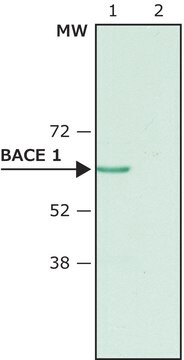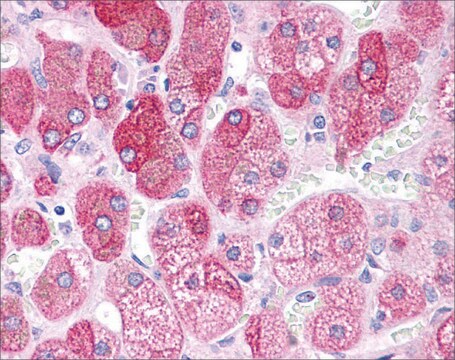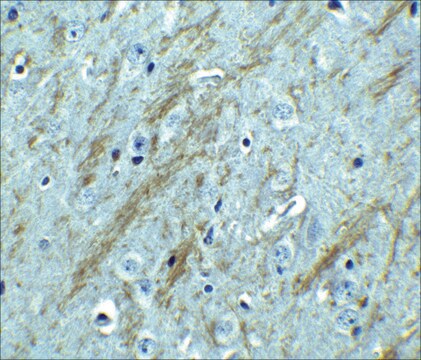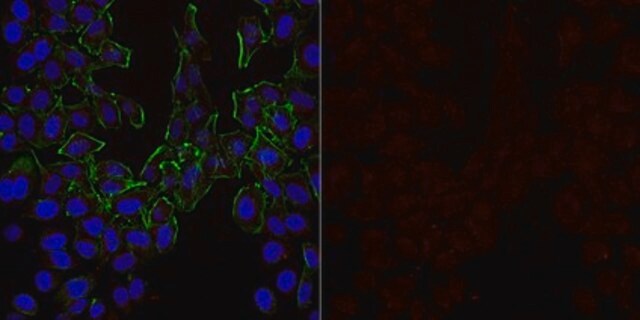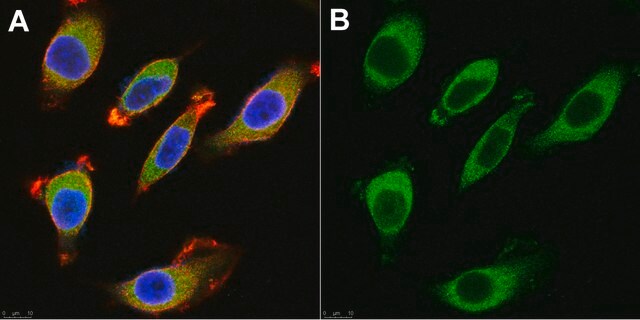推荐产品
生物源
rabbit
共軛
unconjugated
抗體表格
affinity isolated antibody
抗體產品種類
primary antibodies
無性繁殖
polyclonal
形狀
buffered aqueous solution
分子量
antigen 70 kDa
物種活性
human
加強驗證
recombinant expression
Learn more about Antibody Enhanced Validation
技術
microarray: suitable
western blot: 1:1,000 using a whole cell extract from the human kidney HEK293 cell line stably transfected with human BACE-1
UniProt登錄號
運輸包裝
dry ice
儲存溫度
−20°C
目標翻譯後修改
unmodified
基因資訊
human ... BACE1(23621)
一般說明
BACE-1 (β-site APP cleaving enzyme, Asp2 or memapsin 2) is known as β-secretase. BACE-1 is highly expressed in neurons, the major site of Aβ generation. BACE-1 is localized within the Golgi and endosomal compartments, among the several intracellular sites where Aβ is thought to be produced. It constitutes the predominant β-secretase activity in human brain tissue.
免疫原
synthetic peptide corresponding to the C-terminus of human BACE-1 (amino acids 485-501).
應用
Anti-BACE 1, C-Terminus (485-501) antibody produced in rabbit has been used in western blotting.
生化/生理作用
Overexpression of β-site APP cleaving enzyme (BACE-1) leads to increased β-secretase activity while displaying appropriate cleavage site specificity for amyloid precursor protein (APP).
外觀
Solution in 0.01 M phosphate buffered saline, pH 7.4, containing 1% bovine serum albumin and 15 mM sodium azide.
免責聲明
Unless otherwise stated in our catalog or other company documentation accompanying the product(s), our products are intended for research use only and are not to be used for any other purpose, which includes but is not limited to, unauthorized commercial uses, in vitro diagnostic uses, ex vivo or in vivo therapeutic uses or any type of consumption or application to humans or animals.
未找到合适的产品?
试试我们的产品选型工具.
儲存類別代碼
12 - Non Combustible Liquids
水污染物質分類(WGK)
nwg
閃點(°F)
Not applicable
閃點(°C)
Not applicable
Marcus O W Grimm et al.
International journal of molecular sciences, 17(11) (2016-11-02)
One of the characteristics of Alzheimer´s disease (AD) is an increased amyloid load and an enhanced level of reactive oxidative species (ROS). Vitamin E has known beneficial neuroprotective effects, and previously, some studies suggested that vitamin E is associated with
Docosahexaenoic acid reduces amyloid beta production via multiple pleiotropic mechanisms
Grimm MOW, et al.
Test, 286(16), 14028-14039 (2011)
S Prasad Gabbita et al.
PloS one, 10(10), e0137305-e0137305 (2015-10-06)
Cytokines such as TNFα can polarize microglia/macrophages into different neuroinflammatory types. Skewing of the phenotype towards a cytotoxic state is thought to impair phagocytosis and has been described in Alzheimer's Disease (AD). Neuroinflammation can be perpetuated by a cycle of
Marcus O W Grimm et al.
The Journal of biological chemistry, 283(17), 11302-11311 (2008-03-01)
The major molecular risk factor for Alzheimer disease so far identified is the amyloidogenic peptide Abeta(42). In addition, growing evidence suggests a role of cholesterol in Alzheimer disease pathology and Abeta generation. However, the cellular mechanism of lipid-dependent Abeta production
Tatjana L Rothhaar et al.
TheScientificWorldJournal, 2012, 141240-141240 (2012-05-02)
Lipids play an important role as risk or protective factors in Alzheimer's disease (AD). Previously it has been shown that plasmalogens, the major brain phospholipids, are altered in AD. However, it remained unclear whether plasmalogens themselves are able to modulate
我们的科学家团队拥有各种研究领域经验,包括生命科学、材料科学、化学合成、色谱、分析及许多其他领域.
联系技术服务部门

